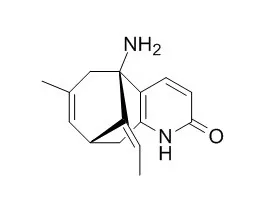| In vitro: |
| Nat Prod Res. 2015 Jun;29(11):1035-41. | | Huperzine A production by Paecilomyces tenuis YS-13, an endophytic fungus isolated from Huperzia serrata.[Pubmed: 25427833] | Huperzine A (HupA), a naturally occurring alkaloid in the plant family Huperziaceae, has drawn great interest for its potential application in Alzheimer disease therapy. Our primary objective was to identify alkaloid- and HupA-producing fungi from the Chinese folk herb, Huperzia serrata.
METHODS AND RESULTS:
We established a rapid and efficient model for screening HupA-producing endophytic fungal strains. The presence of HupA in Paecilomyces tenuis YS-13 was analysed by thin-layer chromatography, high-performance liquid chromatography and mass spectrometry. The fermentation yield of HupA was 21.0 μg/L, and the IC50 of the crude extract of YS-13 fermentation broth was 1.27 ± 0.04 mg/mL.
CONCLUSIONS:
This is the first report of P. tenuis as a HupA-producing endophyte isolated from Huperziaceae. | | Front Aging Neurosci. 2014 Aug 19;6:216. | | Huperzine A: Is it an Effective Disease-Modifying Drug for Alzheimer's Disease?[Pubmed: 25191267] | Alzheimer's disease (AD) is a progressive neurodegenerative disorder for which there is no cure. Huperzine A (HupA) is a natural inhibitor of acetylcholinesterase (AChE) derived from the Chinese folk medicine Huperzia serrata (Qian Ceng Ta). It is a licensed anti-AD drug in China and is available as a nutraceutical in the US.
METHODS AND RESULTS:
A growing body of evidence has demonstrated that HupA has multifaceted pharmacological effects. In addition to the symptomatic, cognitive-enhancing effect via inhibition of AChE, a number of recent studies have reported that this drug has "non-cholinergic" effects on AD. Most important among these is the protective effect of HupA on neurons against amyloid beta-induced oxidative injury and mitochondrial dysfunction as well as via the up-regulation of nerve growth factor and antagonizing N-methyl-d-aspartate receptors.
CONCLUSIONS:
The most recent discovery that HupA may reduce brain iron accumulation lends further support to the argument that HupA could serve as a potential disease-modifying agent for AD and also other neurodegenerative disorders by significantly slowing down the course of neuronal death. | | Neurosignals, 2005, 14(1-2):71-82. | | Neuroprotective Effects of Huperzine A.[Reference: WebLink] | Huperzine A (HupA), isolated from Chinese herb Huperzia serrata, is a potent, highly specific and reversible inhibitor of acetylcholinesterase. It has been found to reverse or attenuate cognitive deficits in a broad range of animal models.
METHODS AND RESULTS:
Clinical trials in China have demonstrated that HupA significantly relieves memory deficits in aged subjects, patients with benign senescent forgetfulness, Alzheimer's disease (AD) and vascular dementia (VD), with minimal peripheral cholinergic side effects compared with other AChEIs in use. HupA possesses the ability to protect cells against hydrogen peroxide, beta-amyloid protein (or peptide), glutamate, ischemia and staurosporine-induced cytotoxicity and apoptosis. These protective effects are related to its ability to attenuate oxidative stress, regulate the expression of apoptotic proteins Bcl-2, Bax, P53 and caspase-3, protect mitochondria, and interfere with APP metabolism. Antagonizing effects on NMDA receptors and potassium currents may contribute to the neuroprotection as well.
CONCLUSIONS:
It is also possible that the non-catalytic function of AChE is involved in neuroprotective effects of HupA. The therapeutic effects of HupA on AD or VD are probably exerted via a multi-target mechanism. |
|






 Cell. 2018 Jan 11;172(1-2):249-261.e12. doi: 10.1016/j.cell.2017.12.019.IF=36.216(2019)
Cell. 2018 Jan 11;172(1-2):249-261.e12. doi: 10.1016/j.cell.2017.12.019.IF=36.216(2019) Cell Metab. 2020 Mar 3;31(3):534-548.e5. doi: 10.1016/j.cmet.2020.01.002.IF=22.415(2019)
Cell Metab. 2020 Mar 3;31(3):534-548.e5. doi: 10.1016/j.cmet.2020.01.002.IF=22.415(2019) Mol Cell. 2017 Nov 16;68(4):673-685.e6. doi: 10.1016/j.molcel.2017.10.022.IF=14.548(2019)
Mol Cell. 2017 Nov 16;68(4):673-685.e6. doi: 10.1016/j.molcel.2017.10.022.IF=14.548(2019)